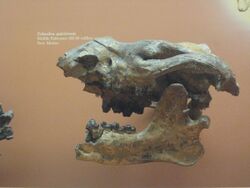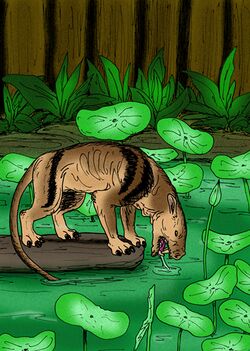Biology:Triisodon
| Triisodon | |
|---|---|

| |
| Skull of T. quivirensis from New Mexico | |
| Scientific classification | |
| Domain: | Eukaryota |
| Kingdom: | Animalia |
| Phylum: | Chordata |
| Class: | Mammalia |
| Order: | †Mesonychia |
| Family: | †Triisodontidae |
| Genus: | †Triisodon Cope, 1881 |
| Species | |
| |
Triisodon is a genus of extinct mesonychian mammal that existed during the Early Paleocene of New Mexico, North America. The genus was named by Edward Drinker Cope in 1881 as a member of the Acreodi, a now invalid taxon that encompassed both creodonts and mesonychians. The premolar teeth have three points, hence the generic name (tri=three, don=tooth).[citation needed] Cope described the type specimen of T. quivirensis as "about the size of a wolf."[2] A smaller species has also been identified from the same region. Since material from this genus is incomplete, the exact size of adults and whether they showed sexual dimorphism or regional variations in size is unknown.
Triisodon is the type genus of the family Triisodontidae, one of the three families within Mesonychia (the other two being Mesonychidae and Hapalodectidae). Other North American triisodontid genera, including Goniacodon, Eoconodon, and Stelocyon, have been referred to Triisodon.[3] Like many very early mammals, the relationship of triisonodontines to other living and fossil mammals has been uncertain, but most paleontologists currently consider them either mesonychids or the sister group of mesonychids, part of the stem group that led to artiodactyls (including whales) and the ancient South American ungulates.[4]
Species
- Genus Triisodon[5]
- Trisonodon crassicuspus (= T. rusticus, Goniacodon, “Conoryctes”)
- Lower Paleocene (Torrejonian). Much smaller than T. quivirensis and with more elongate third promolar; distinguished from Eoconodon by having a somewhat reduced third molar.
- Triisodon quivirensis (= T. antiquus)
- Lower Paleocene (Torrejonian), coexisted in the same habitat with T crassicuspus. Distinguished from T. crassicuspus by much larger size, from Eoconodon as above.
- Triisodon heilprinianus identified by Cope, 1882[6] on the basis of a single molar, has since been referred to multiple groups. Referred to Eoconodon coryphaeus by Kondrashov and Lucas 2006.
- Trisonodon crassicuspus (= T. rusticus, Goniacodon, “Conoryctes”)
References
- ↑ "Triisodon". https://paleobiodb.org/classic/checkTaxonInfo?taxon_no=42904&is_real_user=1.
- ↑ Cope, E. D. (1881). "On Some Mammalia of the Lowest Eocene Beds of New Mexico". Proceedings of the American Philosophical Society 19 (109): 484–495. ISSN 0003-049X.
- ↑ "Mesonychians part III: Andrewsarchus and the triisodontines | ScienceBlogs". https://scienceblogs.com/tetrapodzoology/2009/08/13/mesonychians-part-iii-andrewsa.
- ↑ "Palaeos Vertebrates Laurasiatheria: Eparctocyona". http://palaeos.com/vertebrates/laurasiatheria/eparctocyona.html.
- ↑ Kondrashov, and Spencer Lucas, Peter (January 2006). EARLY_PALEOCENE_PUERCAN_AND_TORREJONIAN_ARCHAIC_UNGULATES_CONDYLARTHRA_PROCREODI_AND_ACREODI_OF_THE_SAN_JUAN_BASIN_NEW_MEXICO. https://www.researchgate.net/publication/281592499.
- ↑ (in en) Journal of Mammalogy. American Society of Mammalogists.. 1981. pp. 683. https://books.google.com/books?id=0EWzAAAAIAAJ&q=%22Triisodon%22+teeth+have+three+points.
External links
Wikidata ☰ Q2602946 entry
 |


